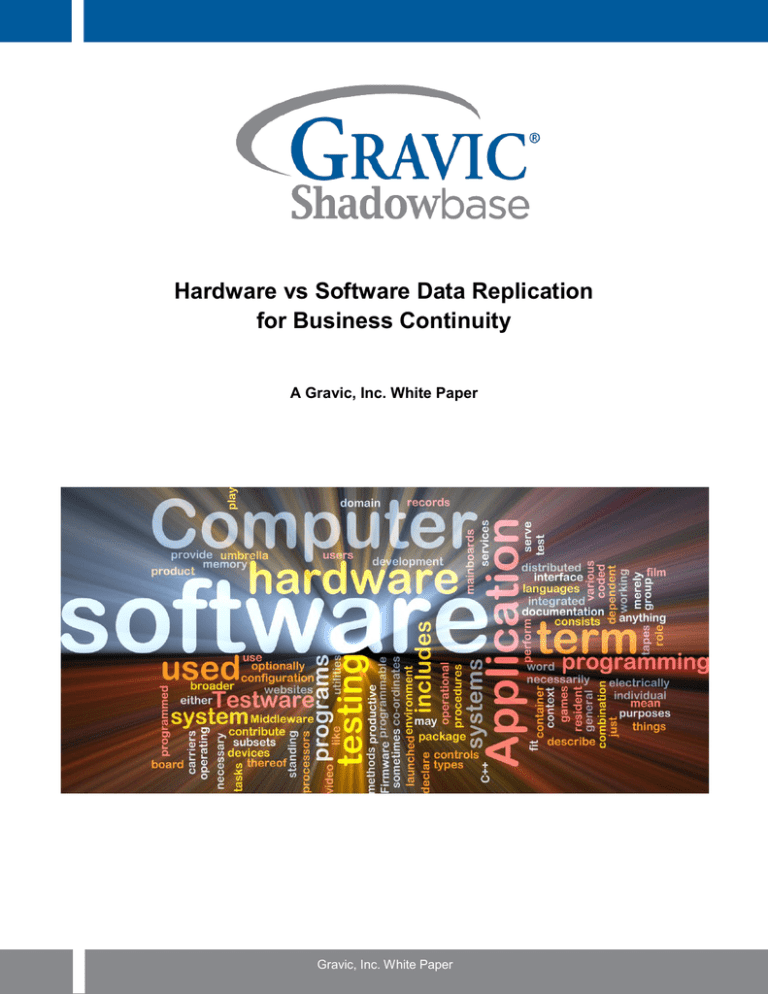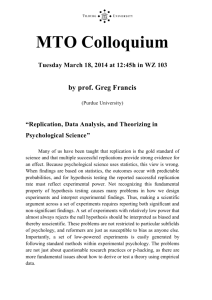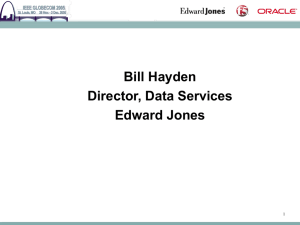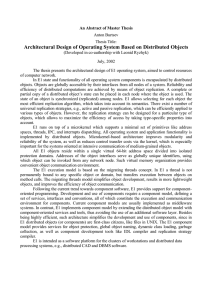Hardware vs Software Data Replication for Business Continuity
advertisement

Hardware vs Software Data Replication for Business Continuity A Gravic, Inc. White Paper Gravic, Inc. White Paper Hardware vs Software Data Replication for Business Continuity Executive Summary Today, businesses with access to real-time online transactional data have a competitive advantage. To gain the greatest benefit from this data, it must be current and available at any given time. The counter to this advantage is that the inability to access or update current data denies service to users, and carries significant business costs, possibly measured in many thousands of dollars per second. These requirements necessitate an IT infrastructure that is continuously available. Business continuity encompasses activities that an enterprise performs to maintain timeliness, consistency and recoverability of its data, operations, and services. Application availability depends upon the ability of IT services to survive any fault, whether it is a server failure, a network fault, or a data center disaster. Data availability depends on the existence of up-to-date backup data copies. Data replication is an enabling technology for achieving high or continuous availability for application services and the timely backup of important data. There are two primary data replication technologies, hardware replication and software replication. With hardware replication, data updates are mirrored to alternate disks at the disk controller or device driver level. With software replication, data updates are read from a database change queue, then forwarded and replayed on remote target systems. In both cases there are remote copies of the source data, but the quality of that data, usability of that data during the replication process, and other differences between the techniques are significant. With hardware replication, the backup data does not maintain referential integrity. Backup data is often unreadable to applications during the replication process as the data and index blocks being replicated are typically inconsistent. For this reason it cannot support the continuous availability levels possible for an active/active business continuity architecture. Since the backup database is inconsistent, it cannot be used for query type applications. Recovery is complex and time consuming (requiring a data “fix-up” at failover to make it consistent), and backup data corruption is possible. Data loss can also occur with synchronous hardware replication. For these and other reasons, hardware data replication does not support the required data availability and data loss requirements for business continuity of mission-critical applications. Software data replication does not suffer from the main issues affecting hardware replication. Since source and target data consistency is maintained, active/active business continuity architectures are fully supported. Very short (sub-second) recovery times are possible, and repeatable. Backup databases are consistent and can be used for online query/reporting type applications. Source data corruption is not replicated. Communication bandwidth requirements are lower, and distance limitations between source and target systems are eliminated. No data loss occurs with synchronous software replication. Consequently, a business continuity architecture built on software data replication is often the only viable solution to meet the service availability and data loss requirements of mission-critical applications. Gravic, Inc. White Paper Page 2 of 11 Hardware vs Software Data Replication for Business Continuity Table of Contents Executive Summary......................................................................................................................................... 2 Introduction ...................................................................................................................................................... 4 Data Replication – The Fundamental Force Behind Business Continuity ................................................ 4 Hardware Data Replication ............................................................................................................................. 4 Software Data Replication .............................................................................................................................. 6 Software Data Replication – Log-Shipping ................................................................................................... 8 Comparison of Hardware vs Software Data Replication ............................................................................. 8 Summary........................................................................................................................................................... 9 Shadowbase Software Data Replication ..................................................................................................... 10 International Partner Information ................................................................................................................. 11 Gravic, Inc. Contact Information .................................................................................................................. 11 Table of Figures Figure 1 – Data Replication..............................................................................................................................4 Figure 2 – Hardware Replication – On Disk Write .........................................................................................5 Figure 3 – Hardware Replication – On Cache Write ......................................................................................5 Figure 4 – Asynchronous Software Replication Engine ...............................................................................7 Figure 5 – Synchronous Software Replication using Coordinated Commits ............................................7 Figure 6 – Software Replication – Log-Shipping ...........................................................................................8 Gravic, Inc. White Paper Page 3 of 11 Hardware vs Software Data Replication for Business Continuity Hardware vs Software Data Replication for Business Continuity Introduction Today, businesses with access to real-time online transactional data have a competitive advantage. To gain the greatest benefit from this data it must be current and available at any given time. The counter to this advantage is that the inability to access or update current data denies service to users and carries significant business costs, possibly measured in many thousands of dollars per second. These requirements necessitate an IT infrastructure that is continuously available. Business continuity encompasses activities that an enterprise performs to maintain timeliness, consistency, and availability of its data, operations, and services. Application availability depends upon the ability of IT services to survive any fault, whether it is a server failure, a network fault, or a data center disaster. Data availability depends on the existence of up-to-date backup data copies. Data replication is an enabling technology for achieving high or continuous availability for application services and the timely backup of important data. There are two primary data replication technologies, hardware replication and software replication. Each of these technologies, and the differences between them, are discussed in this paper. Data Replication – The Fundamental Force Behind Business Continuity Improving availability via data replication depends upon having at least two nodes (or disks), each capable of hosting data. Often, each node will also host the application(s) to be protected – or if remotely hosted, the applications must have a connection enabling access to the data. As shown in Figure 1, the purpose of data replication is to keep target data synchronized in real-time with source data that is being updated by a source application. Data Replication Application Source Database Changes Source System Target Database Target System Figure 1 – Data Replication The source database is hosted by the source node and the target database is hosted by the target node. The two nodes comprise the distributed data processing system. As an application makes changes (inserts, updates, and deletes) to its local source database, these changes are immediately sent by some means to the target system, where they are applied to the target database, which typically resides on another independent node. Because the target database is kept synchronized with the source database, if the source system becomes unavailable, processing can continue using the target system, maintaining service availability. The means by which the data is replicated between the disks on the source system and the disks on the target system falls into one of two categories, hardware replication or software replication. Hardware Data Replication Hardware replication is usually implemented in the storage system controller, which replicates disk blocks (the ‘data’ which is ‘ack’d) to a target disk as they are written to the source disk (Figure 2). If a failure occurs in the source system to which the source disk is attached, a backup system to which the target disk is attached can take over processing. Gravic, Inc. White Paper Page 4 of 11 Hardware vs Software Data Replication for Business Continuity System A System B Disk Controller/ Device Driver Data Ack Ack Source Database Target Database Data Figure 2 – Hardware Replication – On Disk Write However, disk blocks are typically only written to disk when they are flushed from the disk’s cache. There is no logical order to the disk-write sequence since other factors control cache flushing. Disk blocks that are recently the least used are flushed to disk when cache space is needed for new blocks that must be read from disk. As a consequence, the target disk is not guaranteed to be consistent with the source disk; target disk blocks may be partially split; indices may exist without the rows or records to which they refer; and children may exist without parents. The data is consistent in cache, but the target disk image is generally useless. As a result, applications cannot use the target database for any application processing. Because of this inconsistency, if the source node fails, a lengthy recovery process is required to bring the target database into a useful, consistent state, which extends the period of service unavailability. Additionally, if synchronous replication is used, large amounts of data may be lost due to a source-system failure, as any data still in cache will not have been flushed nor replicated at the time of failure. System A System B Disk Controller/ Device Driver Cache Ack Data Data Source Database Target Database Figure 3 – Hardware Replication – On Cache Write Gravic, Inc. White Paper Page 5 of 11 Hardware vs Software Data Replication for Business Continuity Some storage controllers replicate changes as they are made to a disk’s cache regardless of whether or not they have been physically written to the source disk (Figure 3). The replication of cache updates ensures the logical consistency of the target database, since changes are replicated to the target system as soon as they are made at the source system. If synchronous replication is used, no data will be lost following a source system failure. However, due to other limitations (as described next), the target database may still not be useable by applications while replication is occurring. Whether based on disk flushing or cache updates, hardware replication typically sends blocks of changes to the target. In some cases, the controller compresses data to only the changed bytes. In other cases, entire data blocks are sent, which requires high communication bandwidth and co-location of source and target disks. Both hardware replication techniques typically do not replicate current data locking protocols nor transaction end-state information (commits and aborts). Hence, the target database typically contains many “dirty records” and cannot be used by applications or for read-only activities. Hardware replication generally requires identical storage technology, including the version level to be used at both the source and the target. This requirement means it cannot be used to integrate diverse systems and applications, to eliminate islands of information, and implement new business services. Further, if any component is required to be upgraded (for example, to fix a fault), all components must be upgraded at the same time (or else the fault would bring down both components). Hardware replication also typically does not allow the target database to be opened by applications at the same time that replication is taking place, thus preventing their use in active/active systems or for read-only activities, such as offloading reporting from the source database. Consequently, hardware replication is not an option in order to achieve recovery times measured in seconds or minutes. Another issue with hardware replication is that the maximum distance between the source and target disks is limited. Having the target disk insufficiently distant from the source disk increases the chance that a local area incident (e.g., a flood) will affect both the source and target disks and prevent a timely recovery. Software Data Replication Software replication may take place by: event, transaction (several events all treated as a single unit of work), request, or log-shipping, which is discussed further in the following section. Event replication replicates data-manipulation language (DML) events as they occur. DML events include insert, update, and delete operations. In some cases, event replication may also replicate datadefinition language (DDL) operations that affect the database’s data structure and schema. Transaction replication replicates entire transactions, either one operation at a time as they occur, or as a group of operations once the transaction has committed on the source. When replayed at the target, the transaction is either committed or, if the entire transaction is not received, is aborted. Request replication replicates the entire application request, which is reprocessed in its entirety by the application running on the target system. In this paper we are concerned about achieving the highest levels of replication performance, application service availability, data consistency, and minimizing data loss when a failure occurs. Of the various modes of software replication, transaction replication best meets these requirements. In transaction-level software replication, a data replication engine running on the source and target systems performs the replication task. The data replication engine is driven by a queue of database change/update events which are read on the source system and sent to the target system and applied to its database. This form of replication is able to replicate at the transaction level because transaction control information is also replicated, and updates are applied to the target as transactions. That is, either all updates in a transaction are applied, or none are, thereby preserving source transaction consistency at the target database. In addition, the updates are applied to the target system in the same order as they were generated on the source system.1 As a result, the target database can always satisfy all of the requirements of referential integrity and database consistency, and consequently can be used by other applications for both read and write operations (the latter in an active/active architecture). 1 Some high-performance replication engines are multithreaded to improve replication throughput. In these engines, resynchronizing facilities reorder updates that may be received out-of-order from the various threads before the updates are applied to the target database, maintaining target database consistency. Gravic, Inc. White Paper Page 6 of 11 Hardware vs Software Data Replication for Business Continuity Unlike hardware replication, software replication works between heterogeneous systems and databases. This capability enables the integration of diverse applications and data, elimination of islands of information, and implementation of new business services, such as real-time business intelligence. As with hardware replication, software replication may be asynchronous or synchronous. An asynchronous data replication engine is completely transparent to the applications running in the source node. As shown in Figure 4, it extracts changes made to the source database from a database change queue2 and sends them after-the-fact to the target database. Application Changes Change Queue Changes Source Database Asynchronous Replication Source System Target Database Target System Figure 4 – Asynchronous Software Replication Engine Unlike some forms of hardware replication (disk flushing), synchronous software replication guarantees that no data will be lost after a failure. Using a technique known as “coordinated commits”3 (Figure 5), synchronous software replication makes no permanent changes to any database copy unless these changes can be applied to both source and target database copies. With coordinated commits, the replication engine participates in the source application’s transaction, and at commit time, it votes “yes” or “no” dependent upon whether all the updates in the transaction have been replicated to the target system. If “no,” then the source transaction aborts. It is guaranteed that all participating databases received and/or applied the same updates, or none did; therefore no data will be lost in the event of a source system outage. Ready to Commit? Application Changes Yes Change Queue Source Database Changes Asynchronous Replication Engine Source System Target Database Target System Figure 5 – Synchronous Software Replication using Coordinated Commits 2 A database change queue is a DBMS-maintained list of transactional insert, update and delete operations that have been performed against the database. 3 For more information on synchronous replication and coordinated commits, see Dr. Bill Highleyman, Paul J. Holenstein, Dr. Bruce Holenstein, Chapter 4 – Synchronous Replication, Breaking the Availability Barrier: Survivable Systems for Enterprise Computing, AuthorHouse; 2004. Gravic, Inc. White Paper Page 7 of 11 Hardware vs Software Data Replication for Business Continuity Software Data Replication – Log-Shipping System A System B Application Changes Source Database Source Database Change Log Log Shipping Software Target Database Figure 6 – Software Replication – Log-Shipping Log-shipping (Figure 6) is a form of software data replication that operates more like hardware replication. Logshipping sends the entire source database change log periodically to a target system. On the target system this change log is read and the data and index blocks are applied against the physical database structure, which is analogous to how hardware-based data replication works; it also has all of the same issues. Compared to software transaction-based data replication, log-shipping has a higher amount of data loss on failure (higher RPO), because the target database is only current to the point of the most recent log-ship, which may only be when the source log file has been closed. Any subsequent changes on the source system are lost. Log-shipping data is usually applied to the target as index and data blocks of changes, which results in an inconsistent target database, rendering it practically useless while replication is taking place, as is the case with hardware replication. Even if the change events are extracted from the log and applied to the target, source transaction consistency is typically not maintained; events are applied without regard to source transaction bracketing. The result is an inconsistent and unusable target database. Comparison of Hardware vs Software Data Replication Although hardware replication (including software-based log-shipping) appears to offer a simple and costeffective approach to maintaining data and service availability, it is often not a good business continuity solution for the reasons previously discussed: Since there is no concept of transaction boundaries, database consistency or referential integrity, hardware replication cannot be used for active/active systems (i.e., it cannot provide continuous availability). The backup disk is highly inconsistent due to missing data not yet replicated, and is consequently not usable for query/reporting or other functions. The primary and backup systems must generally use identical database hardware and software. All upgrades must be simultaneously applied to all hardware components, thereby increasing the risk that a fault in one component will affect all components. The source and target systems must be homogeneous, and integration of diverse systems, applications, and data is not possible. Recovery from a failure is a complex and lengthy task, requiring data “fix-up” on the backup disk, which leads to long recovery times and service unavailability. A significant amount of communication bandwidth is required since whole disk blocks rather than individual rows are typically replicated. Gravic, Inc. White Paper Page 8 of 11 Hardware vs Software Data Replication for Business Continuity Data corruption of the source database is replicated to the target, perhaps preventing it from being opened for recovery. Distance between disks is physically limited (typically about 100 km), which increases the likelihood that a local area incident could affect both disks and prevent recovery. If synchronous replication is used, data can still be lost when a failure occurs due to the cache flushing issue. By contrast, none of these issues affect software replication: Primary and backup databases are consistent and maintain transactional and referential integrity. Software replication therefore enables active/active systems which deliver continuous service availability. Because software replication maintains database consistency, backup systems can be used for query/reporting and other online activities, while replication is taking place. Primary and backup systems can be completely different (heterogeneous). The platforms, operating systems, database software, and database structure can all be different. The data replication engine takes care of managing the necessary data transformations. Software replication can be used for the integration of different applications and data, enabling the implementation of new business services. Because the backup database is transactionally consistent and ready for use at any time, there is no need for a complex takeover process (database “fix-up” to bring it into a consistent and usable state), and recovery times as low as sub-seconds are possible. In an active/active architecture many users will not see an outage, and recovery is simply a matter of re-routing users from a failed node to an active system. Because only row change data is sent between systems, much less communications bandwidth is required for software replication. Software replication replicates changes described by a source transaction log. Such changes are executed completely independently on target systems, thereby avoiding the mirroring of corruption from the source database to the target database. Software replication has no physical distance limits between nodes, which can be positioned sufficiently far apart to ensure continued service, including an outage incident that affects a wide area. Synchronous software replication guarantees that all data associated with committed transactions is replicated, and hence no data will be lost in the event of failure. Summary On the surface, hardware data replication appears to offer a simple and cost-effective solution to the problem of maintaining data and service availability in the event of a system outage. Scratch the surface however, and it becomes clear that hardware data replication suffers from many significant issues which make it unsuitable for this task. Simply put, the likelihood for a timely recovery from an outage with minimal data loss is very low, and perhaps not possible at all. Furthermore, backup system capacity is wasted since the replicated data is inconsistent and unusable. It will only take one incident for it to become apparent that hardware replication is not cost-effective and does not enable the highest levels of service availability with minimal data loss. Conversely, software-based transactional replication suffers from none of the issues which afflict hardware replication, including: distances are not limited; source and target databases are consistent; recovery is simple, fast, and repeatable; continuously available active/active architectures are supported; zero data loss in synchronous mode; backup databases can be used for productive work; source and target systems can be completely heterogeneous. For mission-critical applications, the highest levels of service availability and protection against data loss is required. A business continuity architecture built on software-based transactional data replication is the only viable solution to meet this requirement. Gravic, Inc. White Paper Page 9 of 11 Hardware vs Software Data Replication for Business Continuity Shadowbase Software Data Replication The Shadowbase product suite from Gravic, Inc. provides the full range of software data replication features to satisfy the most demanding IT business continuity and other replication requirements, including: active/active continuous availability architectures; synchronous replication for zero data loss 4; zero downtime migration (ZDM) eliminates planned downtime; data and application integration between heterogeneous systems. The Gravic white paper, Choosing a Business Continuity Solution to Meet Your Availability Requirements contains more information on the subject of hardware versus software data replication, and the requirements to consider in choosing the best solution to meet your business continuity needs. 4 Synchronous replication for zero data loss is a controlled availability capability. Gravic, Inc. White Paper Page 10 of 11 Hardware vs Software Data Replication for Business Continuity International Partner Information Global Hewlett Packard Enterprise 1501 Page Mill Road #1429 Palo Alto, CA 94304-1100 USA Tel: +1.408.691.2908 www.hpe.com Africa Asia Pacific Japan Business Connexion (Pty) Ltd Business Connexion Park 789 16th Road Randjiespark Midrand South Africa Tel: +27 (0)11 653 5365 www.bcx.co.za Legato Solutions & Services Pte Ltd 10 Ubi Crescent #04-65 Ubi TechPark Singapore 408564 Tel: +65 68463 150 Fax: +65 67489 356 www.legato.com.sg High Availability Systems Co. Ltd MS Shibaura Bldg. 4-13-23 Shibaura Minato-ku, Tokyo 108-0023 Japan Tel: +81 3 5730 8870 Fax: +81 3 5730 8629 www.ha-sys.co.jp Gravic, Inc. Contact Information 17 General Warren Blvd. Malvern, PA 19355-1245 USA Tel: +1.610.647.6250 Fax: +1.610.647.7958 www.shadowbasesoftware.com Email Sales: shadowbase@gravic.com Email Support: sbsupport@gravic.com Copyright and Trademark Information This document is Copyright © 2016 by Gravic, Inc. Gravic, Shadowbase and Total Replication Solutions are registered trademarks of Gravic, Inc. All other brand and product names are the trademarks or registered trademarks of their respective owners. Specifications subject to change without notice. Gravic, Inc. White Paper Page 11 of 11


